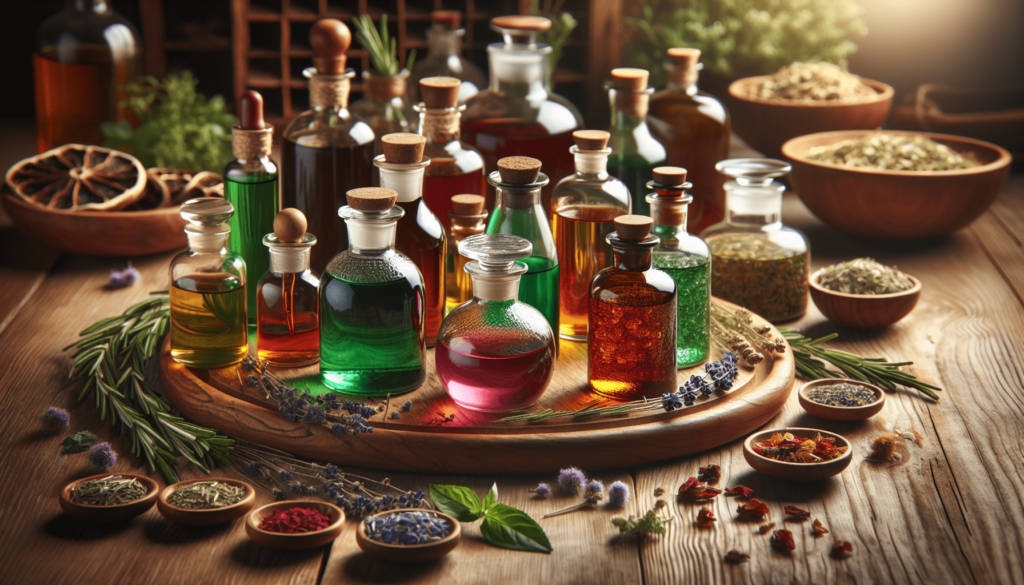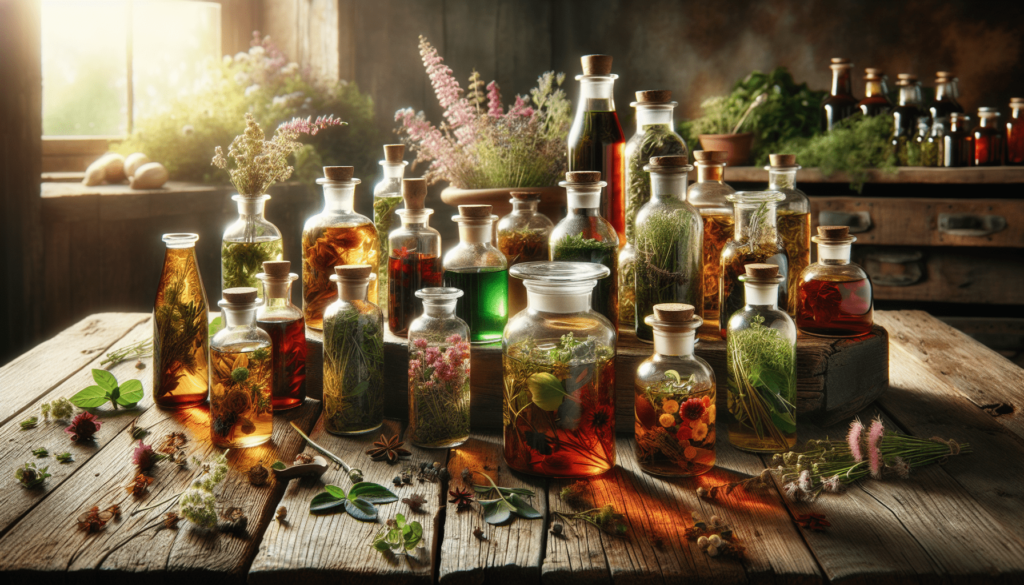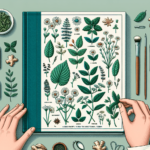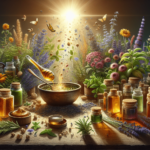So you’re looking to add some natural remedies to your wellness routine, but you’re tired of the same old herbal teas? Look no further – we’ve got the perfect solution for you! In this article, we’ll introduce you to 10 mouthwatering herbal tincture recipes that are not only beneficial for your health but also packed with flavors that will leave your taste buds wanting more. From soothing lavender and chamomile blends to invigorating ginger and lemon combinations, these recipes will surely satisfy your herbal cravings. Get ready to embark on a delicious journey towards enhanced wellness!

1. Lemon Balm Tincture
Ingredients
- Fresh lemon balm leaves
- High-proof alcohol
Instructions
- Collect a handful of fresh lemon balm leaves.
- Rinse the leaves to remove any dirt or debris.
- Chop the leaves into smaller pieces to release their oils.
- Fill a glass jar halfway with the chopped leaves.
- Pour the high-proof alcohol over the leaves, ensuring they are fully submerged.
- Close the jar tightly and give it a good shake.
- Store the jar in a cool, dark place for 2-4 weeks, shaking it occasionally.
- After the steeping period, strain the liquid through a fine-mesh strainer or cheesecloth.
- Pour the tincture into dark glass bottles and label them accordingly.
- Store the bottles in a cool, dark place.
Benefits and Uses
Lemon balm tincture is known for its calming properties and can be used to reduce anxiety and promote relaxation. It can also help with sleeping difficulties and improve overall mood. Additionally, it has antibacterial properties and can be used topically to treat cold sores and other skin infections. Lemon balm tincture can be taken orally or applied topically for the desired benefits.
2. Calendula Tincture
Ingredients
- Dried calendula flowers
- High-proof alcohol
Instructions
- Measure out a cup of dried calendula flowers.
- Place the flowers in a glass jar.
- Pour the high-proof alcohol over the flowers, making sure they are completely covered.
- Seal the jar tightly and give it a gentle shake.
- Store the jar in a dark and cool place for 4-6 weeks.
- Shake the jar occasionally during this steeping period.
- After the waiting period, strain the liquid through a fine-mesh strainer or cheesecloth.
- Transfer the tincture into dark glass bottles and label them appropriately.
- Store the bottles in a cool, dark place.
Benefits and Uses
Calendula tincture is renowned for its anti-inflammatory and antibacterial properties. It can be used topically to soothe and heal various skin conditions such as cuts, scrapes, and burns. Calendula tincture can also be ingested to support digestive health and relieve menstrual cramps. It is a versatile herbal remedy with a wide range of applications.
3. Chamomile Tincture
Ingredients
- Dried chamomile flowers
- High-proof alcohol
Instructions
- Gather a cup of dried chamomile flowers.
- Place the flowers in a glass jar.
- Pour the high-proof alcohol over the flowers, ensuring they are fully submerged.
- Close the jar tightly and give it a gentle shake.
- Keep the jar in a dark and cool location for 4-6 weeks.
- Shake the jar occasionally during this steeping period.
- After the steeping period, strain the liquid through a fine-mesh strainer or cheesecloth.
- Transfer the tincture to dark glass bottles and label them accordingly.
- Store the bottles in a cool, dark place.
Benefits and Uses
Chamomile tincture is well-known for its calming and soothing properties. It can be used to alleviate anxiety, promote better sleep, and relieve stress. Chamomile tincture also possesses anti-inflammatory properties and can be applied topically to soothe skin irritations and rashes. Consuming chamomile tincture can aid in digestion and help alleviate symptoms of indigestion. It is a gentle and fragrant herbal remedy suitable for various applications.
4. Lavender Tincture
Ingredients
- Dried lavender blossoms
- High-proof alcohol
Instructions
- Measure out a cup of dried lavender blossoms.
- Place the blossoms in a glass jar.
- Pour the high-proof alcohol over the blossoms, ensuring they are completely covered.
- Seal the jar tightly and give it a gentle shake.
- Store the jar in a dark and cool place for 4-6 weeks.
- Shake the jar occasionally during the steeping period.
- After the steeping period, strain the liquid through a fine-mesh strainer or cheesecloth.
- Pour the tincture into dark glass bottles and label them accordingly.
- Store the bottles in a cool, dark place.
Benefits and Uses
Lavender tincture is renowned for its calming and relaxing properties. It can be used to alleviate anxiety, stress, and promote restful sleep. Lavender tincture is also known for its analgesic properties and can be applied topically to relieve minor pain or headaches. Additionally, it possesses antiseptic properties and can be used to clean wounds or as a natural insect repellent. Lavender tincture is highly versatile and can be used in various ways for its beneficial effects.

5. Echinacea Tincture
Ingredients
- Dried echinacea root or leaves
- High-proof alcohol
Instructions
- Measure out a cup of dried echinacea root or leaves.
- Place the echinacea in a glass jar.
- Pour the high-proof alcohol over the echinacea, ensuring it is completely submerged.
- Close the jar tightly and give it a gentle shake.
- Store the jar in a dark and cool place for 6-8 weeks.
- Shake the jar occasionally during the steeping period.
- After the waiting period, strain the liquid through a fine-mesh strainer or cheesecloth.
- Transfer the tincture to dark glass bottles and label them accordingly.
- Store the bottles in a cool, dark place.
Benefits and Uses
Echinacea tincture is used to support the immune system and can be taken as a preventive measure against colds and flu. It is also believed to help alleviate symptoms of upper respiratory infections and may reduce the duration of the illness. Echinacea tincture can be taken orally to boost immunity or applied topically to aid in wound healing. It is a popular herbal remedy to support overall well-being and enhance the body’s natural defenses.
6. Ginger Tincture
Ingredients
- Fresh ginger root
- High-proof alcohol
Instructions
- Peel and chop a cup of fresh ginger root.
- Place the chopped ginger in a glass jar.
- Pour the high-proof alcohol over the ginger, ensuring it is fully submerged.
- Seal the jar tightly and give it a good shake.
- Store the jar in a dark and cool place for 4-6 weeks.
- Shake the jar occasionally during the steeping period.
- After the steeping period, strain the liquid through a fine-mesh strainer or cheesecloth.
- Transfer the tincture to dark glass bottles and label them accordingly.
- Store the bottles in a cool, dark place.
Benefits and Uses
Ginger tincture is known for its anti-inflammatory properties and can be used to alleviate various types of pain, including headaches and joint pain. It is also considered beneficial for digestive health and can help relieve symptoms of indigestion, nausea, and bloating. Ginger tincture can be taken orally or added to beverages and culinary dishes to add a spicy and warming flavor. It is a versatile herbal remedy with a wide range of uses.
7. Valerian Tincture
Ingredients
- Dried valerian root
- High-proof alcohol
Instructions
- Measure out a cup of dried valerian root.
- Place the valerian in a glass jar.
- Pour the high-proof alcohol over the valerian, ensuring it is fully submerged.
- Close the jar tightly and give it a gentle shake.
- Store the jar in a dark and cool place for 6-8 weeks.
- Shake the jar occasionally during the steeping period.
- After the waiting period, strain the liquid through a fine-mesh strainer or cheesecloth.
- Transfer the tincture to dark glass bottles and label them accordingly.
- Store the bottles in a cool, dark place.
Benefits and Uses
Valerian tincture is widely used as a natural remedy for insomnia and sleep disorders. It has a calming effect on the nervous system and can help alleviate anxiety and promote a restful night’s sleep. Valerian tincture can also aid in relieving tension and muscle spasms and may be used to support relaxation during times of stress. It is a popular herbal remedy for those seeking non-pharmaceutical sleep aids.
8. St. John’s Wort Tincture
Ingredients
- Dried St. John’s Wort flowers
- High-proof alcohol
Instructions
- Measure out a cup of dried St. John’s Wort flowers.
- Place the flowers in a glass jar.
- Pour the high-proof alcohol over the flowers, ensuring they are fully covered.
- Close the jar tightly and give it a gentle shake.
- Store the jar in a dark and cool place for 4-6 weeks.
- Shake the jar occasionally during the steeping period.
- After the waiting period, strain the liquid through a fine-mesh strainer or cheesecloth.
- Pour the tincture into dark glass bottles and label them accordingly.
- Store the bottles in a cool, dark place.
Benefits and Uses
St. John’s Wort tincture is commonly used to alleviate symptoms of mild to moderate depression and anxiety. It is believed to possess mood-enhancing properties and can help regulate serotonin levels in the brain. St. John’s Wort tincture may also be used topically to support wound healing and relieve symptoms of nerve pain. It is an herbal remedy that is commonly used to promote emotional well-being.
9. Peppermint Tincture
Ingredients
- Fresh peppermint leaves
- High-proof alcohol
Instructions
- Collect a handful of fresh peppermint leaves.
- Rinse the leaves to remove any dirt or debris.
- Chop the leaves into smaller pieces to release their oils.
- Fill a glass jar halfway with the chopped leaves.
- Pour the high-proof alcohol over the leaves, ensuring they are fully submerged.
- Close the jar tightly and give it a good shake.
- Store the jar in a cool, dark place for 2-4 weeks, shaking it occasionally.
- After the steeping period, strain the liquid through a fine-mesh strainer or cheesecloth.
- Transfer the tincture into dark glass bottles and label them accordingly.
- Store the bottles in a cool, dark place.
Benefits and Uses
Peppermint tincture is known for its refreshing and cooling properties. It can be taken orally to aid in digestion, relieve symptoms of bloating and gas, and provide relief from nausea. Peppermint tincture can also be used topically to soothe itching and irritation caused by insect bites or skin rashes. Additionally, it has analgesic properties and can be applied to temples to help alleviate headaches. Peppermint tincture is a versatile and invigorating herbal remedy.
10. Dandelion Tincture
Ingredients
- Dandelion roots or leaves
- High-proof alcohol
Instructions
- Gather a cup of fresh dandelion roots or leaves.
- Rinse the roots or leaves to remove any dirt or debris.
- Chop the roots or leaves into smaller pieces.
- Place the chopped roots or leaves in a glass jar.
- Pour the high-proof alcohol over the roots or leaves, ensuring they are fully covered.
- Close the jar tightly and give it a good shake.
- Store the jar in a dark and cool place for 4-6 weeks.
- Shake the jar occasionally during the steeping period.
- After the waiting period, strain the liquid through a fine-mesh strainer or cheesecloth.
- Transfer the tincture into dark glass bottles and label them accordingly.
- Store the bottles in a cool, dark place.
Benefits and Uses
Dandelion tincture is commonly used to support liver health and aid in detoxification. It can help stimulate bile production and promote healthy digestion. Dandelion tincture is also believed to have diuretic properties and can assist in flushing out toxins from the body. Additionally, it has been used to support healthy skin and may help alleviate skin conditions such as acne or eczema. Dandelion tincture is a well-rounded herbal remedy with various potential benefits.
By following these recipes and instructions, you can create a range of herbal tinctures that offer different benefits and uses. Remember to always do your research on the potential effects and precautions associated with each herb before incorporating them into your daily routine. Enjoy experimenting with these natural remedies and discover the benefits they can bring to your well-being and overall health.





